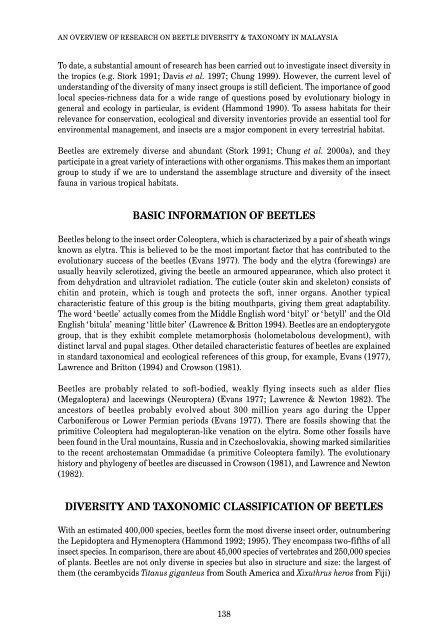o_19ko2dt161ng2j4e1tgnoqv1s45a.pdf
You also want an ePaper? Increase the reach of your titles
YUMPU automatically turns print PDFs into web optimized ePapers that Google loves.
AN OVERVIEW OF RESEARCH ON BEETLE DIVERSITY & TAXONOMY IN MALAYSIA<br />
To date, a substantial amount of research has been carried out to investigate insect diversity in<br />
the tropics (e.g. Stork 1991; Davis et al. 1997; Chung 1999). However, the current level of<br />
understanding of the diversity of many insect groups is still deficient. The importance of good<br />
local species-richness data for a wide range of questions posed by evolutionary biology in<br />
general and ecology in particular, is evident (Hammond 1990). To assess habitats for their<br />
relevance for conservation, ecological and diversity inventories provide an essential tool for<br />
environmental management, and insects are a major component in every terrestrial habitat.<br />
Beetles are extremely diverse and abundant (Stork 1991; Chung et al. 2000a), and they<br />
participate in a great variety of interactions with other organisms. This makes them an important<br />
group to study if we are to understand the assemblage structure and diversity of the insect<br />
fauna in various tropical habitats.<br />
BASIC INFORMATION OF BEETLES<br />
Beetles belong to the insect order Coleoptera, which is characterized by a pair of sheath wings<br />
known as elytra. This is believed to be the most important factor that has contributed to the<br />
evolutionary success of the beetles (Evans 1977). The body and the elytra (forewings) are<br />
usually heavily sclerotized, giving the beetle an armoured appearance, which also protect it<br />
from dehydration and ultraviolet radiation. The cuticle (outer skin and skeleton) consists of<br />
chitin and protein, which is tough and protects the soft, inner organs. Another typical<br />
characteristic feature of this group is the biting mouthparts, giving them great adaptability.<br />
The word ‘beetle’ actually comes from the Middle English word ‘bityl’ or ‘betyll’ and the Old<br />
English ‘bitula’ meaning ‘little biter’ (Lawrence & Britton 1994). Beetles are an endopterygote<br />
group, that is they exhibit complete metamorphosis (holometabolous development), with<br />
distinct larval and pupal stages. Other detailed characteristic features of beetles are explained<br />
in standard taxonomical and ecological references of this group, for example, Evans (1977),<br />
Lawrence and Britton (1994) and Crowson (1981).<br />
Beetles are probably related to soft-bodied, weakly flying insects such as alder flies<br />
(Megaloptera) and lacewings (Neuroptera) (Evans 1977; Lawrence & Newton 1982). The<br />
ancestors of beetles probably evolved about 300 million years ago during the Upper<br />
Carboniferous or Lower Permian periods (Evans 1977). There are fossils showing that the<br />
primitive Coleoptera had megalopteran-like venation on the elytra. Some other fossils have<br />
been found in the Ural mountains, Russia and in Czechoslovakia, showing marked similarities<br />
to the recent archostematan Ommadidae (a primitive Coleoptera family). The evolutionary<br />
history and phylogeny of beetles are discussed in Crowson (1981), and Lawrence and Newton<br />
(1982).<br />
DIVERSITY AND TAXONOMIC CLASSIFICATION OF BEETLES<br />
With an estimated 400,000 species, beetles form the most diverse insect order, outnumbering<br />
the Lepidoptera and Hymenoptera (Hammond 1992; 1995). They encompass two-fifths of all<br />
insect species. In comparison, there are about 45,000 species of vertebrates and 250,000 species<br />
of plants. Beetles are not only diverse in species but also in structure and size: the largest of<br />
them (the cerambycids Titanus giganteus from South America and Xixuthrus heros from Fiji)<br />
138



